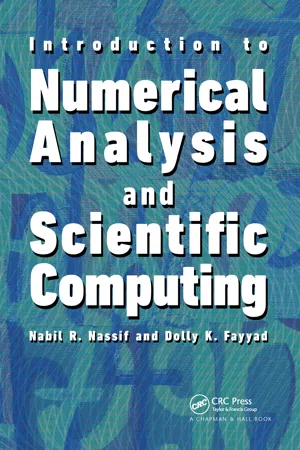
eBook - ePub
Introduction to Numerical Analysis and Scientific Computing
Nabil Nassif, Dolly Khuwayri Fayyad
This is a test
Buch teilen
- 329 Seiten
- English
- ePUB (handyfreundlich)
- Über iOS und Android verfügbar
eBook - ePub
Introduction to Numerical Analysis and Scientific Computing
Nabil Nassif, Dolly Khuwayri Fayyad
Angaben zum Buch
Buchvorschau
Inhaltsverzeichnis
Quellenangaben
Über dieses Buch
Designed for a one-semester course, Introduction to Numerical Analysis and Scientific Computing presents fundamental concepts of numerical mathematics and explains how to implement and program numerical methods. The classroom-tested text helps students understand floating point number representations, particularly those pertaining to IEEE simple an
Häufig gestellte Fragen
Wie kann ich mein Abo kündigen?
Gehe einfach zum Kontobereich in den Einstellungen und klicke auf „Abo kündigen“ – ganz einfach. Nachdem du gekündigt hast, bleibt deine Mitgliedschaft für den verbleibenden Abozeitraum, den du bereits bezahlt hast, aktiv. Mehr Informationen hier.
(Wie) Kann ich Bücher herunterladen?
Derzeit stehen all unsere auf Mobilgeräte reagierenden ePub-Bücher zum Download über die App zur Verfügung. Die meisten unserer PDFs stehen ebenfalls zum Download bereit; wir arbeiten daran, auch die übrigen PDFs zum Download anzubieten, bei denen dies aktuell noch nicht möglich ist. Weitere Informationen hier.
Welcher Unterschied besteht bei den Preisen zwischen den Aboplänen?
Mit beiden Aboplänen erhältst du vollen Zugang zur Bibliothek und allen Funktionen von Perlego. Die einzigen Unterschiede bestehen im Preis und dem Abozeitraum: Mit dem Jahresabo sparst du auf 12 Monate gerechnet im Vergleich zum Monatsabo rund 30 %.
Was ist Perlego?
Wir sind ein Online-Abodienst für Lehrbücher, bei dem du für weniger als den Preis eines einzelnen Buches pro Monat Zugang zu einer ganzen Online-Bibliothek erhältst. Mit über 1 Million Büchern zu über 1.000 verschiedenen Themen haben wir bestimmt alles, was du brauchst! Weitere Informationen hier.
Unterstützt Perlego Text-zu-Sprache?
Achte auf das Symbol zum Vorlesen in deinem nächsten Buch, um zu sehen, ob du es dir auch anhören kannst. Bei diesem Tool wird dir Text laut vorgelesen, wobei der Text beim Vorlesen auch grafisch hervorgehoben wird. Du kannst das Vorlesen jederzeit anhalten, beschleunigen und verlangsamen. Weitere Informationen hier.
Ist Introduction to Numerical Analysis and Scientific Computing als Online-PDF/ePub verfügbar?
Ja, du hast Zugang zu Introduction to Numerical Analysis and Scientific Computing von Nabil Nassif, Dolly Khuwayri Fayyad im PDF- und/oder ePub-Format sowie zu anderen beliebten Büchern aus Matemáticas & Matemáticas general. Aus unserem Katalog stehen dir über 1 Million Bücher zur Verfügung.
Information
Chapter 1
Computer Number Systems and Floating Point Arithmetic
1.1Introduction
1.2Conversion from Base 10 to Base 2
1.2.1Conversion of the Integral Part
1.2.2Conversion of the Fractional Part
1.3Conversion from Base 2 to Base 10
1.3.1Polynomial Evaluation
1.3.2Conversion of the Integral Part
1.3.3Conversion of the HYactional Part
1.4Normalized Floating Point Systems
1.4.1Introductory Concepts
1.4.2IEEE Floating Point Systems
1.4.3Denormalized Numbers in MATLAB
1.4.4Rounding Errors in Floating Point Representation
1.5Floating Point Operations
1.5.1Algebraic Properties in Floating Point Operations
1.5.2The Problem of Absorption
1.5.3The Problem of Cancellation or Loss of Precision
1.6Computing in a Floating Point System
1.6.1Cardinality and Distribution of Floating Point Systems
1.6.2A MATLAB Simulation of a Floating Point System
1.6.3Tips for Floating Point Computation
1.7Exercises
1.8Computer Projects
1.1 Introduction
The main objective of this chapter is to introduce the students to modes of storage of users’ numbers in a computer memory and as well providing the readers with basic concepts of computer arithmetic, referred to also as Floating Point Arithmetic. Although the principles covered are general and can apply to any finite precision arithmetic system, we apply those principles only to Single and Double Precision IEEE (Institute of Electrical and Electronics Engineers) systems. For additional detailed references, we refer to [8], [14], [19] and [23].
In this view, we start by describing computer number representation in the binary system that uses 2 as the base. Since the usual decimal system uses base 10, we discuss therefore methods of conversion from one base to another. The octal and hexadecimal systems (respectively, base 8 and base 16 systems) are also introduced as they are often needed as intermediate stages b...